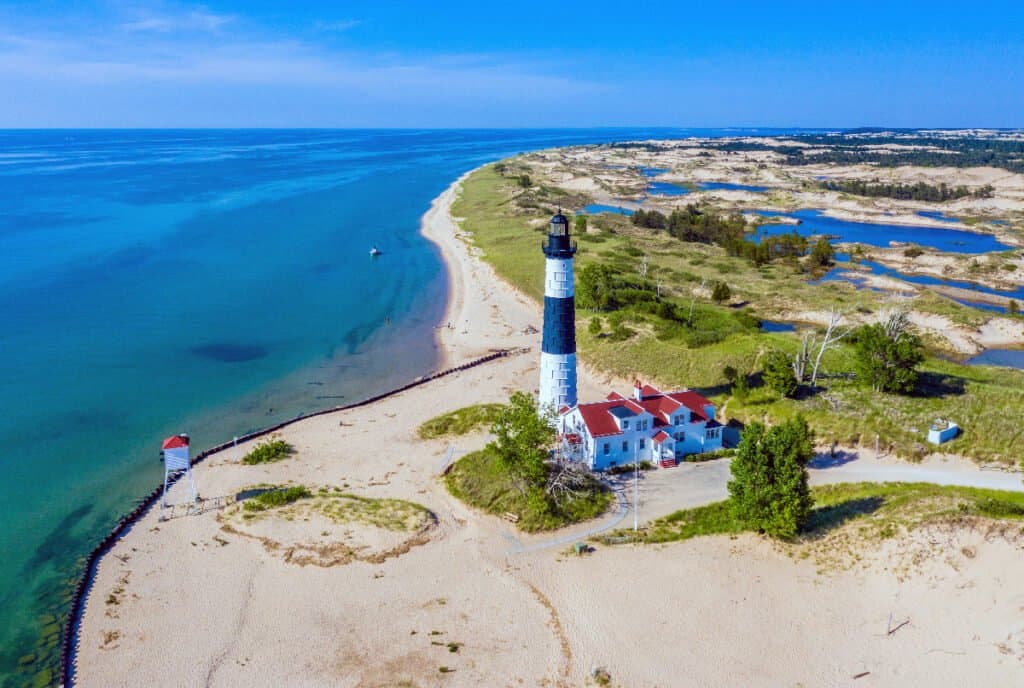Although Chicago is often referred to as the “Windy City,” it is also called the “City by the Lake” as it is close to one of the country’s most famous lakes, Lake Michigan. If you live near Illinois, Indiana, Wisconsin, and Michigan, you might have encountered the famous Lake Michigan. It is one of the North American Great Lakes and ranks the third-largest among the five, based on its water surface. Lake Michigan is an open lake that connects straight to Lake Huron via the Straits of Mackinac in the north. The currents in the lake are mild, as nearly 100 streams and rivers flow into it, most of which are of considerable sizes. Yet, if you dive deeper, you’ll discover that the lake has a lot more to offer. Although Lake Michigan does not top as the largest of the five Great Lakes, it boasts an amazingly enormous surface area and water volume. So, how big is Lake Michigan? And what other amazing facts does the lake hold?
How Big is Lake Michigan?

Lake Michigan is one of the biggest lakes in the United States, stretching 118 miles wide.
©Frederick Millett/Shutterstock.com
Lake Michigan ranks third among the Great Lakes when it comes to the surface area, but it is one of the biggest lakes within the confines of the United States. So, just how big is Lake Michigan? Bordered and shared by four states, namely, Michigan in the east and north, Illinois in the southwest, Indiana in the southeast, and Wisconsin in the west, the lake extends at 321 miles or 517 kilometers long. It stretches at a maximum of 118 miles or 190 kilometers wide. The lake’s water surface measures 22,300 square miles or 57,800 square kilometers, touching expansive shorelines that boast great dune regions. Lake Michigan is the fifth largest lake globally and belongs to the world’s largest freshwater lakes. All five Great Lakes hold nearly 20% of Earth’s freshwaters. Since the Great Lakes are all connected by a diverse web of streams, rivers, and lakes, the North American Great Lakes comprise the world’s biggest freshwater system. Lake Michigan alone holds approximately 1,200 cubic miles of water, equivalent to one quadrillion gallons of water. That’s how vast it is! According to satellite measurements, one would need to drain the lake for about 400 billion gallons to decrease its water level by one inch.
How big is Lake Michigan compared to Lake Superior? While draining Lake Superior, the largest of all lakes in North America, would take about two centuries to finish, draining Lake Michigan would take decades. The average water replacement time in Lake Michigan is 62 years. Every one drop of water that flows into the lake would take more than half a century to flow out of it. About 35% of the United States’ rivers flow into the lake, including Michigan’s major rivers. Some rivers flowing into Lake Michigan include Pere Marquette, White, Muskegon, Kalamazoo, Grand, St. Joseph, and The Manistee. Lake Michigan also has a network of islands located at the lake’s northern end, including the largest, Beaver Island. Compared to the other Great lakes, Lake Michigan may seem to hold only a few titles.
With varying depths, Lake Michigan’s deepest point lies at the Chippewa Basin, located approximately 36 miles east of Wisconsin, Door Peninsula, and Forestville. Lake Michigan has a maximum depth of 923 feet or 281 meters, with a mean surface elevation of 579 feet or 176 meters above sea level. It may not qualify as one of the Earth’s deepest lakes, but it sure possesses a vast mass of water to bury remnants of shipwrecks.
5 Amazing Lake Michigan Facts
Lake Michigan has many amazing features, such as its world-famous beaches and dunes and being the only Great Lake within the confines of the United States. Lake Michigan may be one of North America’s greatest freshwater sources, but its beauty and wonders extend beyond that. Below, we will look at 5 amazing Lake Michigan facts that you may not know about.
1. Lake Michigan is less than 15,000 years old.

Lake Michigan’s basin was formed 1.2 billion years ago.
©JaySi/Shutterstock.com
Less than 15,000 years ago, a giant inland depression or basin in the U.S was filled with melting glaciers, forming one of the world’s largest lakes, Lake Michigan. However, despite becoming a lake less than 15 millennia ago, the lake’s basin was formed 1.2 billion years ago after a tectonic activity that drifted tectonic plates apart in opposite directions. In this event known as the Midcontinent Rift, a gigantic scar was born, becoming what then would be Lake Michigan’s giant basin.
Jean Nicolet, a French explorer, was the first European to glimpse Lake Michigan in 1634 after he was ordered to find the “Northwest Passage.” In 1673, Louis Jolliet, another French explorer, and Jacques Marquette, a French missionary, charted the lake’s western shore from Green Bay to Chicago. The Ojibwa Indian term michigami, which means “large lake,” inspired the lake’s name.
2. Lake Michigan is the only all-American lake among North American Great Lakes.

Lake Michigan is the only Great Lake confined within the U.S.
©Renray/Shutterstock.com
The five Great Lakes in North America are spread throughout the continent, mostly touching various states in the U.S, including other cities and areas in Canada and other parts of the continent. However, Lake Michigan is the only Great Lake confined within the United States territory. Although two Canadian provinces border and touch the four Great Lakes, Lake Michigan is the only lake among them that does not touch Canada.
Lake Michigan touches four major states, with nearly 12 million people settling along the lake’s shores. The Straits of Mackinac, a 4 to 5-mile-wide canal that connects Lake Michigan and Lake Huron on the northern end, apparently makes these two bodies of water one lake.
3. Lake Michigan’s shore hosts the largest freshwater dunes in the world.

Lake Michigan is home to the largest freshwater dune system in the world.
©Sean Pavone/Shutterstock.com
Lake Michigan is home to many shores and beaches, making it even more famous among residents and tourists. There are many beaches along its shores, and the Great Lakes are frequently referred to as the “Third Coast” after the Pacific and Atlantic Oceans. But with over 275,000 acres of dunes bordering its shores, Lake Michigan becomes home to the largest freshwater dune system on the planet, making up the lake’s famous beaches.
The world’s greatest collection of freshwater sand dunes is found along Michigan’s western coast, including Sleeping Bear Dunes National Lakeshore and several more protected dunes. Sleeping Bear’s tallest dune rises around 450 feet above Lake Michigan’s beach. These beaches have 59 lighthouses that remind the centuries-old shipping industry’s relevance.
4. Lake Michigan has its own Bermuda Triangle.
Lake Michigan may be a lake of many wonders, but it has its history of shipwrecks and disappearances. The Michigan Triangle, inspired by the infamous Bermuda Triangle, is an area in Lake Michigan where many inexplicable phenomena have left people perplexed. Unaccounted-for missing ships and aviation disappearances have been reported in the area. Apart from the sea mishaps, archeologists have also discovered an interesting prehistoric boulder with a mastodon carving and blocks of stones arranged like Stonehenge.
Like the other Great Lakes, Lake Michigan has had its fair share of sea mishaps. The sinking of the Westmoreland in 1854 is one of the most well-known maritime tragedies at the lake. In 2010, a diver discovered the wreck in great shape, 155 years after the catastrophe. The Straits of Mackinac might have been a very perilous location to navigate before radar was invented in the 1940s. Unpredictable storms, severe currents, ice, shallow places, fogs, and rocky shoals put ships at risk. Many ships perished while attempting to sail through this narrow strait. So many ships have sunk in the area that an underwater preserve was established where divers could investigate the buried ships. Of the estimated 6,000 vessels that perished in the Great Lakes, Lake Michigan claims 1,500 of them.
5. Lake Michigan is home to rich wildlife.
Something that certainly did not “disappear” in Lake Michigan is its rich collection of various animal species. This lake hosts rich marine biodiversity and complex ecosystems like the Great Lakes. Among the fish species that call it home include salmon, walleyes, trouts, and smallmouth bass. Since over 100 rivers and streams flow into the lake, many of these fish species have traveled or migrated from other freshwater habitats. So, Lake Michigan provides vast opportunities for fishing.
Here are some of the fish and other marine creatures that can be found in Lake Michigan:
Aquatic birds such as swans, geese, and ducks inhabit the lake. Lake Michigan is also home to other bird species like crows, robins, and bald eagles. Due to the abundance of wildlife to feast on, predatory birds such as hawks and vultures are also common on the lake. Apart from the fact that this lake has excellent waters, it also hosts tallgrass prairies, marshes, forests, and savannas that provide suitable habitats for its dwellers.
Thank you for reading! Have some feedback for us? Contact the AZ Animals editorial team.








